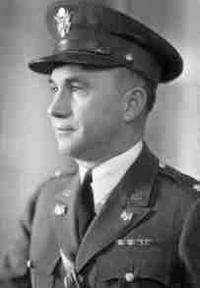

Albert Samuel Peake
Commanding Officer 22nd Infantry
November 10, 1939 - November 11, 1941
Albert S. Peake was born in San Bernadino, California on March 27, 1885.
He graduated from the University
of California in 1908 and was given a commission
in the Philippine Constabulary. He served in the Constabulary
from July 1908 to
February 1911 and rose from Lieutenant to the rank of Lieutenant
Colonel in that organization.
Photo and article from |
|
From 1907-1909 a Philippine
pirate and bandit leader named Jikiri from the island of Jolo had
caused
considerable trouble in the Sulu archipelago and along the coast
of Mindanao. Combined forces of
the Regular U.S. Army and the Philippine Constabulary were
employed to bring his activities to an end.
In January 1909 Albert Peake, as a young Lieutenant in the
Constabulary had an encounter with a sapit
(sailing vessel) containing members of Jikiri's band. The
following passage describes the action:
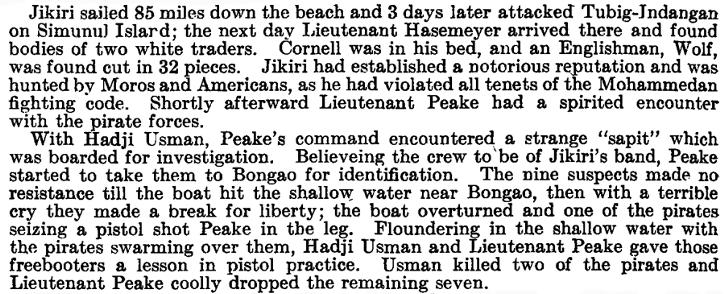
Above passage from:
Hearings Before the Committee on Invalid
Pensions House of Representatives Seventy-ninth Congress
First Session on H.R. 128 and H.R. 3251, Philippine
Uprisings and Campaigns after July 4, 1902, and
prior to January 1, 1914 by Charles V. Stevens pp.40
|
After his service with the
Philippine Constabulary Left and below: Peake got his photo and an
article about him The San Francisco Call
|
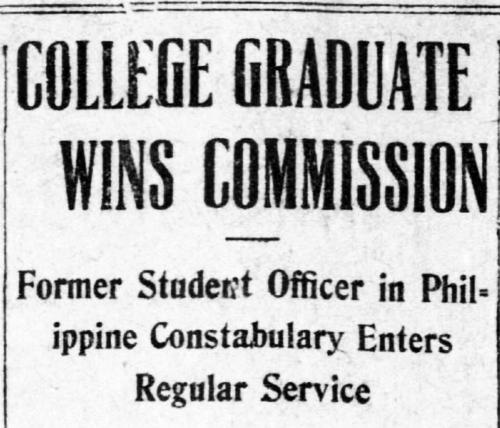
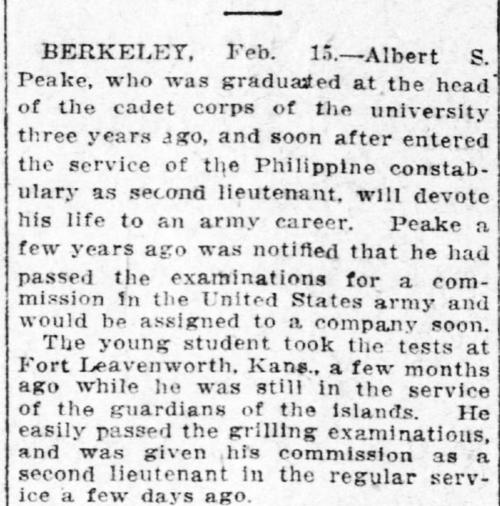
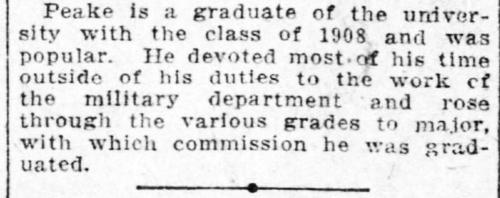
CDNC California Digital Newspaper Collection
Peake was commissioned a 2nd
Lieutenant in the 6th Infantry on February 11, 1911,
which he accepted on March 1, 1911. He was promoted to 1st
Lieutenant on July 1, 1916.
He was with his regiment as part of the Mexican Expedition led by
Brigadier General
John J. Pershing in 1916-1917.
Peake was promoted to Captain of the 6th Infantry on May 15, 1917.
On June 7, 1918 he was offered a
promotion to Major in the National Army, which he accepted
on June 27, 1918. During World War I he commanded the 305th
Machine Gun Battalion
of the 77th Division in France, taking part in the Meuse-Argonne
and Oise-Aisne campaigns.
As a Major, Albert S. Peake was
in command of the 305th Machine Gun Battalion
which saw action in France during the Meuse-Argonne Offensive. An
insight into
Peake's persona is illustrated by the following passages from a
book written about that Battalion:
The next
morning, bright and early, what was our surprise to hear Major
Peake acting as his own bugler. Who can forget
the sight as he strode up and down the road? I can still hear him
bellowing at the top of his lungs "The cooks will get up
and start preparing breakfast. The stable crews will feed and
water the horses. The horses are tired as well as the men.
That's a command of execution and I want action." Heads came
up from blankets all over the place to see what it was
all about and as quickly disappeared beneath the blankets to
smother a few pleasantries. What was said under those blankets
will not bear repeating here. We might say, though, that the
cooks did get up and the stable crews did feed and water the
animals. ¹
One morning,
while at calisthenics, Major Peake congratulated Lieutenant
Winslow Williams for the manner in which the men
were snapping into attention. We tipped off the Lieutenant that
the Major was coming and we were set for anything. He said,
"Lieutenant, it does the heart of an old soldier good to see
the men snap into attention." We might mention that Lieut.
Williams
blushed to the roots of his hair and took time out for a good
laugh. The Major was not there then. Trained as we were with
the British system, the Major bawled us out, on another occasion,
for not knowing the American drill. He told us that we would
find the drill in the book and advised us to read it. What he
failed to do was to produce the book. ²
Entering the
village of Lochere, at the edge of the forest, our march came to
an end and we remained there for four days.
This little group of buildings was just another of the devastated
villages in the war zone but it will remain in the minds
of the 305th Machine Gunners as the scene of the famous hollow
square formation of the Battalion. It was here that
Major Peake unburdened himself of another of his choice speeches
after the four companies had been drawn up facing
inward in the form of a hollow square. Astride his horse, he
bellowed, "This town is dirty and you men will see to it
that
you do not make it any dirtier. You men have been defecating all
over France. It will have to be stopped so that when we leave
this village it will be cleaner than when we came into it."
Those may not have been his exact words but we are sure of the
word,
defecating. In fairness to the officers of the Battalion it must
be said that the companies were never allowed to leave a mess
behind
but had to police up. ³
Peake was honorably discharged
from the National Army on June 30, 1920.
He was promoted to Major in the Regular Army on July 1, 1920.
He graduated from the Infantry
School Advanced Course in 1925, the General Staff School in 1926,
and the Army War College in 1932. He was detailed to the National
Guard Bureau on April 15, 1934.
He received a promotion to Lieutenant Colonel on August 1, 1935.
In 1937 he represented the National
Guard Bureau as an inspector of the 4th Army maneuvers at Fort
Lewis, Washington and at San Luis
Obispo, California. Peake was relieved from the detail to the
National Guard Bureau
on April 14, 1938 and promoted to Colonel on January 1, 1940.
Peake commanded the 22nd Infantry from November 10, 1939 to November 11, 1941.
Colonel Earl Edwards, who was a
Battalion Commander and Regimental S-3 of the 22nd Infantry
during
World War II, served as a young Lieutenant under Colonel Albert
Peake in the 22nd Infantry.
Edwards wrote the following remarks about Peake:
Now a word about
Col. Peake, my first regimental commander,. He was the epitome of
the old army having nearly
30 years of service at that time. The words, gruff, frosty,
stiff, all business, direct and to the point, come to mind
when I remember him. I don't think many sentimental thoughts ever
crossed his mind and he was little given to humor.
I can't remember him laughing. He was strict and considered the
Department of Army regulations his Bible; he meant
for you to follow them. Straight-laced would also fit him-one
time when he was inspecting training on a horse he rode up
to a group of men and a sergeant used a curse world. Col. Peake
got off his horse, walked over to the sergeant, and said,
"Sergeant, if you ever use a curse word in my presence
again, you will be a private the rest of your career". He
then
mounted his horse and rode off. I found him to be very fair. He
was a very competent commander as long as we stayed
on foot but once we started using motors he was lost. He just
couldn't adapt from the horse pace to the motor pace.
from the memoirs of Colonel Earl W.
"Lum" Edwards
Thanks to John and Gladys King for sharing the memoirs of Colonel Edwards with the 1st Battalion website
Albert S. Peake retired from the Army on February 28, 1942 and received a disability in the line of duty.
Peake was recalled to active
duty on March 1, 1942. On May 3, 1943 he was assigned to the
Adjutant General's Department where he served until relieved of
this duty on October 31, 1945.
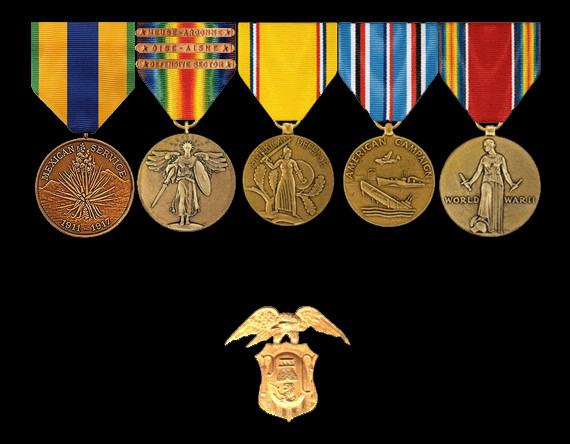
Albert S. Peake's decorations
At the bottom is the cap badge of an officer of the Philippine Constabulary adopted in 1907
Albert S. Peake died in Washington, D.C. on April 21, 1966 and is buried in Arlington National Cemetery
Section 8 Grave 241-A-B
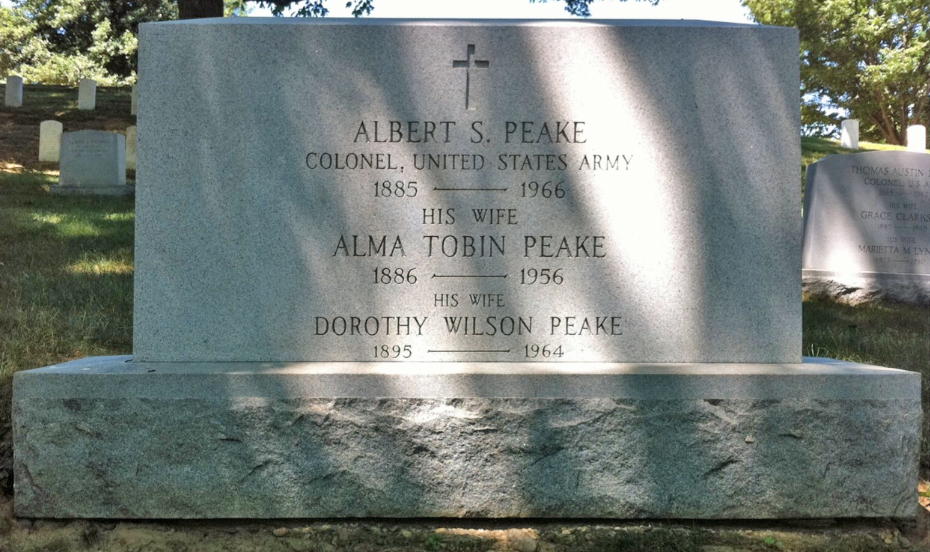
Grave marker for Albert S. Peake
Photo from the Arlington National Cemetery website
¹ A story of the 305th Machine Gun
Battalion, 77th Division, A.E.F.,
by Henry Waterbury Smith, Modern Composing Room, New York 1941,
Chapter 13.
² Ibid., Chapter 17.-----------------------------------------------------
³ Ibid., Chapter 19.-----------------------------------------------------
Home | Photos | Battles & History | Current |
Rosters & Reports | Medal of Honor | Killed
in Action |
Personnel Locator | Commanders | Station
List | Campaigns |
Honors | Insignia & Memorabilia | 4-42
Artillery | Taps |
What's New | Editorial | Links |